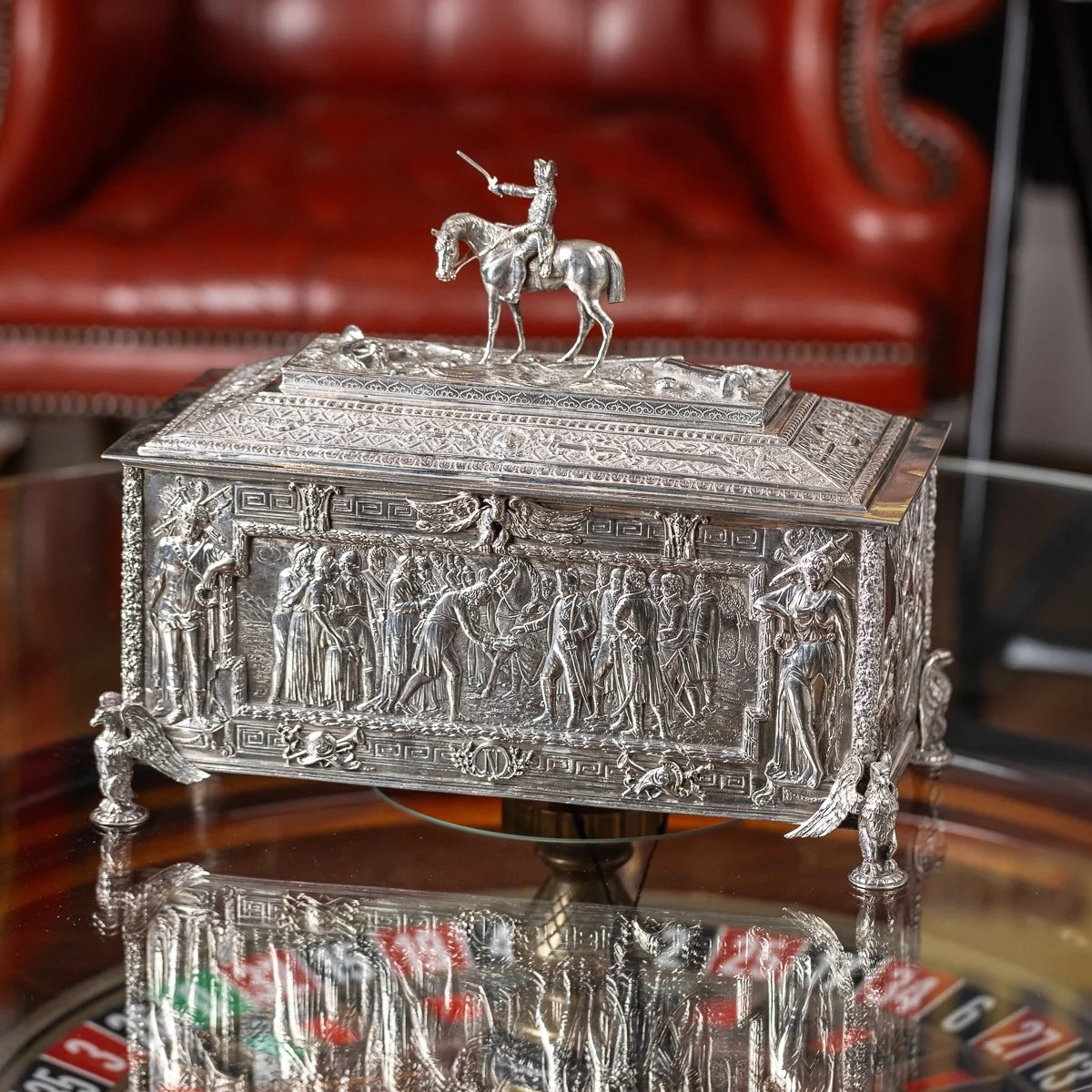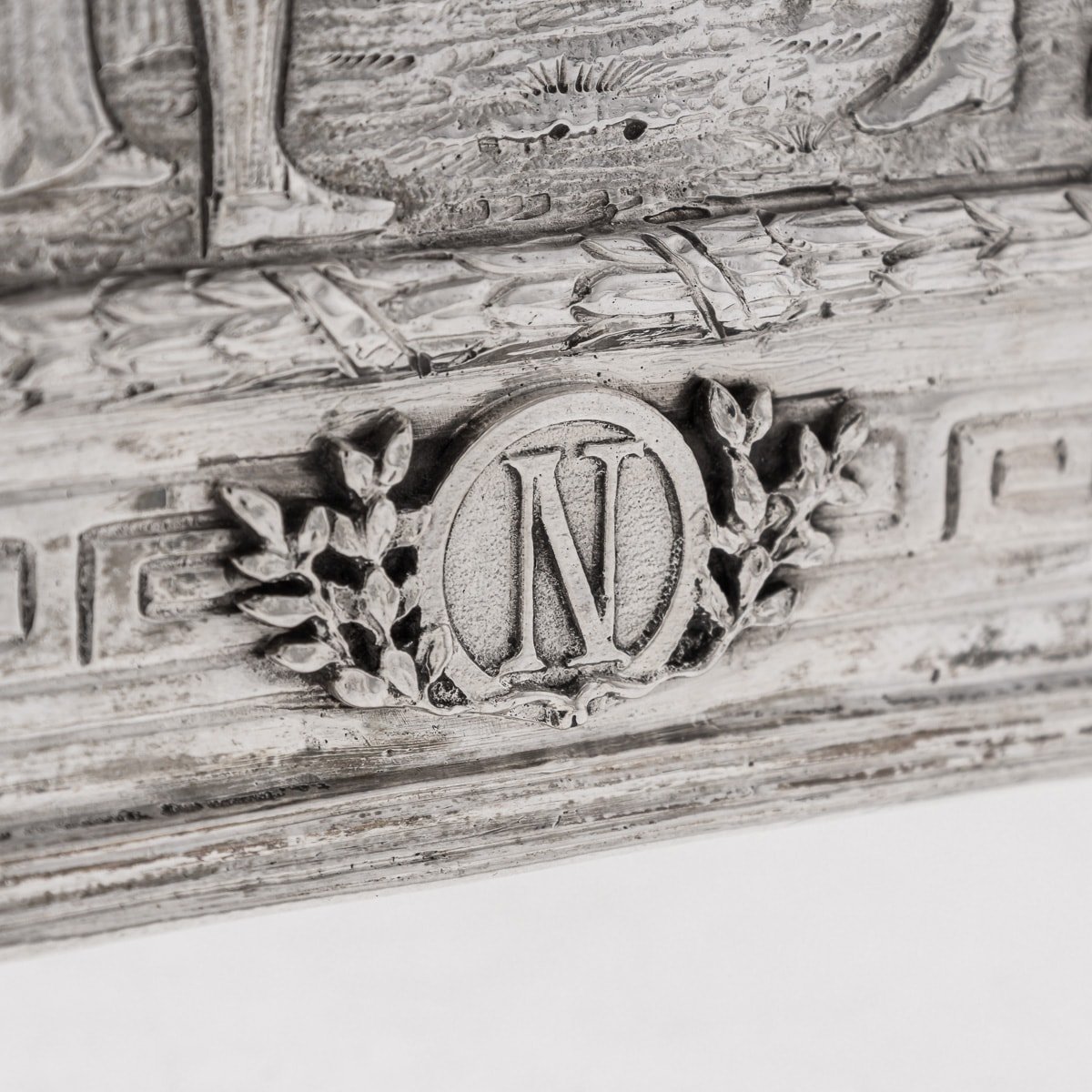ANTIQUE 20thC GERMAN SOLID SILVER "THE TRIUMPH OF NAPOLEON" CASKET c.1900
Antique early 20th Century German solid silver casket, decorated with scenes known as 'The Triumph of Napoleon'. This rectangular sarcophagus-shaped piece features intricate scenes on its panels: the front depicts Napoleon receiving the key to the city of Vienna, while the rear showcases Napoleon amidst courtiers. Classical figures, trophies, and Napoleon's arms adorn the two side panels, with Greek key bands decorating the borders. The casket stands on four eagle supports, with a hinged cover topped by a figure of Napoleon on horseback. Its interior is gilt, housing an internal lock (though the key is missing). The casket is inspired by Anne-Louis Girodet de Roussy-Trioson's 1808 painting titled "Napoleon Bonaparte receiving the keys of Vienna at the Schloss Schönbrunn", the front panel scene commemorates Napoleon's swift victory over the Austrian army in the Ulm Campaign (25 September to 20 October 1805) and subsequent capture of Vienna on 13 November 1805. Hallmarked German silver (800+ standard), Hanau, Maker's mark for Georg Roth (1891 - 1919).
Reference Number: A10264
Antique early 20th Century German solid silver casket, decorated with scenes known as 'The Triumph of Napoleon'. This rectangular sarcophagus-shaped piece features intricate scenes on its panels: the front depicts Napoleon receiving the key to the city of Vienna, while the rear showcases Napoleon amidst courtiers. Classical figures, trophies, and Napoleon's arms adorn the two side panels, with Greek key bands decorating the borders. The casket stands on four eagle supports, with a hinged cover topped by a figure of Napoleon on horseback. Its interior is gilt, housing an internal lock (though the key is missing). The casket is inspired by Anne-Louis Girodet de Roussy-Trioson's 1808 painting titled "Napoleon Bonaparte receiving the keys of Vienna at the Schloss Schönbrunn", the front panel scene commemorates Napoleon's swift victory over the Austrian army in the Ulm Campaign (25 September to 20 October 1805) and subsequent capture of Vienna on 13 November 1805. Hallmarked German silver (800+ standard), Hanau, Maker's mark for Georg Roth (1891 - 1919).
Reference Number: A10264
Antique early 20th Century German solid silver casket, decorated with scenes known as 'The Triumph of Napoleon'. This rectangular sarcophagus-shaped piece features intricate scenes on its panels: the front depicts Napoleon receiving the key to the city of Vienna, while the rear showcases Napoleon amidst courtiers. Classical figures, trophies, and Napoleon's arms adorn the two side panels, with Greek key bands decorating the borders. The casket stands on four eagle supports, with a hinged cover topped by a figure of Napoleon on horseback. Its interior is gilt, housing an internal lock (though the key is missing). The casket is inspired by Anne-Louis Girodet de Roussy-Trioson's 1808 painting titled "Napoleon Bonaparte receiving the keys of Vienna at the Schloss Schönbrunn", the front panel scene commemorates Napoleon's swift victory over the Austrian army in the Ulm Campaign (25 September to 20 October 1805) and subsequent capture of Vienna on 13 November 1805. Hallmarked German silver (800+ standard), Hanau, Maker's mark for Georg Roth (1891 - 1919).
Reference Number: A10264
ADDITIONAL INFORMATION
Not much is known about Georg Roth and the history behind his name. He first worked for the Hanauer Silberwaren Manufaktur (1891-1906) and only used his own mark, a crowned GR for Georg Roth from 1906. Based in Hanau, Germany, not far from Frankfurt, Roth specialised in fine copies from the antique, in the most popular historical styles and in particular French Rococo.
Together with Neresheimer and Schleissner he contributed in creating a solid silver industry tradition in the city. His artworks show a very high quality and they often bare pseudo French marks in the Rococo style that they imitate. Festoons and medallions, ribbon tied laurel boughs and classical bacchanalian scenes are typical of his production.
Although the German law required a minimum silver content of 800/1000, Hanau silver pieces are often marked as 925 sterling silver. In fact, a large amount of Hanau silver was made to be exported to England of US, were the silver standards were higher.
CONDITION
In Great Condition - Wear expected with age. Please refer to photographs.
SIZE
Height: 29.5 cm // 11.61 in
Width: 34.5 cm // 13.58 in
Depth: 17 cm // 6.69 in
Weight: 2634 g // 92.81 oz
























































